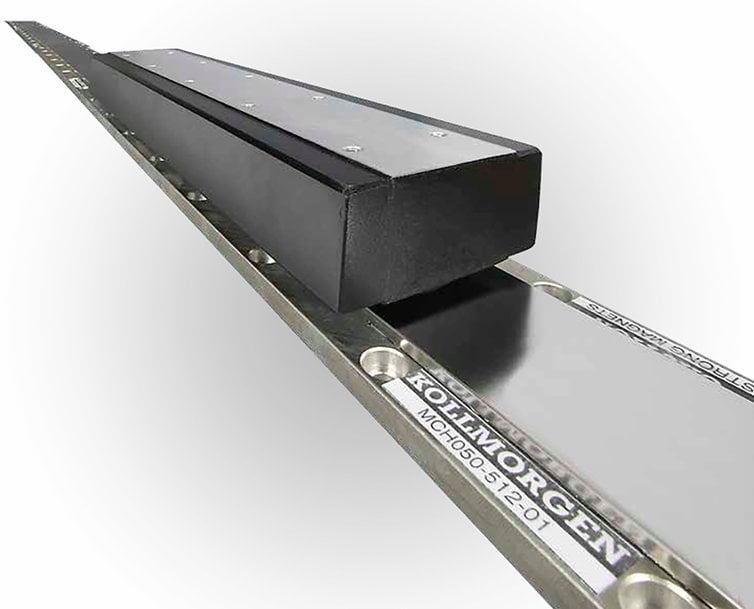www.magazine-industry-usa.com
08
'22
Written on Modified on
Inmoco: Direct-drive motion systems can reduce the total cost of ownership
Direct-drive motion solutions have a performance advantage over conventional mechanical transmission systems but this comes at a premium. However, considering the value of the reduction in the total cost of ownership that can be presented to end users, integrating a direct-drive solution could help OEMs increase their rewards. With fewer components involved, a direct-drive solution can also speed up and simplify machine build.

Gerard Bush, engineer at motion solution design specialist, INMOCO, discusses the cost-saving advantages of direct-drive systems.
Thanks to a feedback system that couples directly to the load, direct-drive motion systems remove the need for mechanical transmission. The advantage of doing away with a gearbox means fewer moving parts and hence, less vibration. As a result, this achieves quieter and more efficient operation, and also creates smoother performance, ideal whether it’s driving a production machine or a medical device.
Along with the performance advantages of a direct-drive motion solution, their integration can also help reduce the total cost of ownership. As a crucial focus for end users, the overall cost effectiveness of direct-drive motors can add value to OEM design compared to a conventional system. As an individual cost, a direct-drive solution carries a higher premium. However, the accumulated advantages of the total value over time can increase the value of the solution you’re offering.
The most obvious and immediate advantage is the upfront cost saving through the elimination of conventional mechanical components. Gears, pulleys, seals, and bearings can be removed from the initial cost of the system, and while a direct-drive solution is more expensive on face value, already we begin to off-set the cost.
Fewer mechanical parts also save cost for the OEM as it simplifies and reduces design time, and it also speeds up installation and lowers the work involved. There’s no need to assemble, mount, and align pulleys, bearings, and belts – plus their safety guards. If an oversized motor is required, this can also need complex and time consuming tuning to match inertia levels with the gearbox. Instead, directly mounted to the machine and self supported through its own bearings, a direct-drive system ensures integration out of the box, removing the time required for set-up. Ultimately, this system reduces the cost of machine build and the higher the build volume, the greater the savings potential.
The absence of mechanical parts also removes any cost of replacement for the end user. This takes away the cost of the parts themselves, from gears to lead screws, as well as the cost in the procurement process. Equally significant, it also eliminates the maintenance cost in labour, whether through the manhours of an in-house team, or external service provider.
The maintenance required for parts replacement also causes a more serious problem of downtime for the end user. Mechanical transmission requires additional scheduled maintenance breaks. If this doesn’t happen periodically, unscheduled downtime can have more serious consequences for overall machine health and productivity. While a machine is out of action, whether through maintenance and repair of gears and associated components, or breakdown, this is costing the end user money by diminishing throughput. While a direct drive solution has fewer parts to maintain, it’s reliability for the OEM’s customer is significantly higher.
Even without the challenges of maintenance and breakdown, the throughput achieved by a direct-drive system is typically higher considering the performance advantage. The elimination of mechanical transmission removes issues of hysteresis or backlash, while increasing dynamic performance and positional accuracy. The ability to make more, at a high quality, and at a faster rate, delivers an advantage that adds value to the machine user.
Similarly, the ability to create a smaller machine design also adds value to the end user, looking to increase the efficiency of real estate and floor space. A direct-drive solution is inherently more compact than its mechanical transmission counterpart – and it also removes any space required for stocking spare parts.
Considering real world applications, cost savings will depend on the machine design and requirements, as well as industry and market dynamics. Particularly where the value of lower total cost of ownership can be sold to end users, the calculation that OEMs make can be beneficial. INMOCO assists OEM design engineers integrate direct-drive solutions from Kollmorgen, ensuring the performance of the motion solution, as well as facilitating a holistic approach to machine design.
www.inmoco.com

